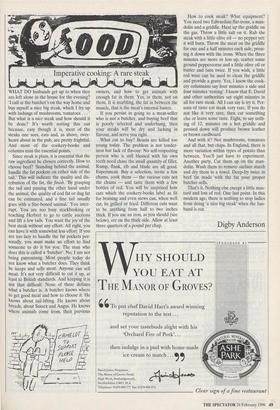Imperative cooking: A rare steak
WHAT DO husbands get up to when they are left alone in the house for the evening? `I call at the butcher's on the way home and buy myself a nice big steak, which I fry up with lashings of mushrooms, tomatoes . . . ' But what is a nice steak and how should it be done? It's worth sorting this out because, easy though it is, most of the steaks one sees, eats and, as above, over- hears about in the pub, are pretty frightful. And most of the cookery-books and columns miss the essential points.
Since steak is plain, it is essential that the raw ingredient be chosen correctly. How to choose beef? 'Standing behind the animal, handle the fat pockets on either side of the tail.' This will indicate the quality and dis- tribution of the fat, the finish. 'By grasping the tail and passing the other hand under the animal, the quality of cod fat or dug fat can be estimated, and a fine tail usually goes with a fine-boned animal.' You inter- rupt. You are too busy stockbroking or teaching Herbert to go to cattle auctions and lift a few tails. You want the joy of the best steak without any effort. All right, you can have it with somewhat less effort. If you are too lazy to handle the fat pockets per- sonally, you must make an effort to find someone to do it for you. The man who does this is called a 'butcher'. No, I am not being patronising. Most people today do not know what a butcher does. They think he keeps and sells meat. Anyone can sell meat. It's not very difficult to cut it up, at least to British standards. And keeping it is not that difficult. None of these defines what a butcher is. A butcher knows where to get good meat and how to choose it. He knows about tail-lifting. He knows about breeds, about Sussex and Angus. He knows where animals come from, their previous owners, and how to get animals with enough fat in them. Yes, in them, not on them. It is marbling, the fat in between the muscle, that is the meat's internal baster.
If you persist in going to a meat-seller who is not a butcher, and buying beef that is poorly selected and underhung, then your steaks will be dry and lacking in flavour, and serve you right.
What cut to buy? Beasts are killed too young today. The problem is not tender- ness but lack of flavour. No self-respecting person who is still blessed with his own teeth need chase the small quantity of fillet. Rump, flank, rib and blade are all good. Experiment. Buy a selection, invite a few chums, cook them — the various cuts not the chums — and taste them with a few bottles of red. You will be surprised how cuts which the cookery-books label as fit for braising and even stews can, when well cut, be grilled or fried. Different cuts want to be anything from half to two inches thick. If you use an iron, as you should (see below), err on the thick side. Allow at least three quarters of a pound per chap. HQW to cook steak? What equipment? You need two Edwardian flat-irons, a man- dolin and a griddle. Heat up the griddle on the gas. Throw a little salt on it. Rub the steak with a little olive oil — no pepper yet: it will burn. Throw the meat on the griddle for one and a half minutes each side, press- ing it down with the irons. When the three minutes are more or less up, scatter some ground peppercorns and a little olive oil or butter and turn twice. If you wish, a little red wine can be used to clean the griddle and provide a gravy. Yes, I know the cook- ery columnists say four minutes a side and four minutes 'resting'. I know that E. David and other authorities say eight minutes in all for rare steak. All I can say is try it. Per- sons of taste eat steak very rare. If you do not like it very rare, then eat something else or learn some taste. Eight, to say noth- ing of 12, minutes on a hot griddle and pressed down will produce brown leather or brown cardboard.
And with it? Not mushrooms, tomatoes and all that, but chips. In England, there is more variation within types of potato than between. You'll just have to experiment. Another party. Cut them up on the man- dolin. Wash them to remove surface starch and dry them in a towel. Deep-fry twice in beef fat made with the fat your proper butcher sells.
That's it. Nothing else except a little mus- tard and lots of red. One last point. In this modern age, there is nothing to stop ladies from doing 'a nice big steak' when the hus- band is out.
Digby Anderson


























































 Previous page
Previous page